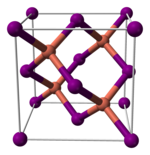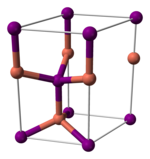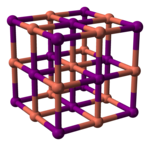Copper(I) iodide

| |
| Names | |
|---|---|
| IUPAC name
Copper(I) iodide
| |
| Other names
Cuprous iodide, marshite
| |
| Identifiers | |
3D model (
JSmol ) |
|
| ChemSpider | |
ECHA InfoCard
|
100.028.795 |
PubChem CID
|
|
| UNII | |
CompTox Dashboard (EPA)
|
|
| |
| |
| Properties | |
| CuI | |
| Molar mass | 190.45 g/mol |
| Appearance | White solid |
| Odor | odorless |
| Density | 5.67 g/cm3 [1] |
| Melting point | 606 °C (1,123 °F; 879 K) |
| Boiling point | 1,290 °C (2,350 °F; 1,560 K) (decomposes) |
| 0.000042 g/100 mL | |
Solubility product (Ksp)
|
1.27 x 10−12 [2] |
| Solubility | soluble in ammonia and iodide solutions insoluble in dilute acids |
| Vapor pressure | 10 mm Hg (656 °C) |
| -63.0·10−6 cm3/mol | |
Refractive index (nD)
|
2.346 |
| Structure | |
zincblende
| |
| Tetrahedral anions and cations | |
| Hazards | |
| GHS labelling: | |
  
| |
| Danger | |
| H302, H315, H319, H335, H410 | |
| P261, P273, P305+P351+P338, P501 | |
| NFPA 704 (fire diamond) | |
| Flash point | Non-flammable |
| NIOSH (US health exposure limits): | |
PEL (Permissible)
|
TWA 1 mg/m3 (as Cu)[3] |
REL (Recommended)
|
TWA 1 mg/m3 (as Cu)[3] |
IDLH (Immediate danger) |
TWA 100 mg/m3 (as Cu)[3] |
| Safety data sheet (SDS) | Sigma Aldrich |
| Related compounds | |
Other anions
|
|
Other cations
|
silver iodide |
Except where otherwise noted, data are given for materials in their standard state (at 25 °C [77 °F], 100 kPa).
| |
Copper(I) iodide is the inorganic compound with the formula CuI. It is also known as cuprous iodide. It is useful in a variety of applications ranging from organic synthesis to cloud seeding.
Copper(I) iodide is white, but samples often appear tan or even, when found in nature as rare mineral marshite, reddish brown, but such color is due to the presence of impurities. It is common for samples of iodide-containing compounds to become discolored due to the facile aerobic oxidation of the iodide anion to molecular iodine.[4][5][6]
Structure
Copper(I)
 |
 |

|
| γ-CuI | β-CuI | α-CuI |
Preparation
Copper(I) iodide can be prepared by heating iodine and copper in concentrated
In the laboratory however, copper(I) iodide is prepared by simply mixing an aqueous solution of potassium iodide and a soluble copper(II) salt such as copper(II) sulfate.[4]
- Cu2+ + 2I− → CuI + 0.5 I2
Reactions
Copper(I) iodide reacts with mercury vapors to form copper tetraiodomercurate:
- 4 CuI + Hg → Cu2HgI4 + 2 Cu
This reaction can be used for the detection of mercury since the white (CuI) to brown (Cu2HgI4) color change is dramatic.
Copper(I) iodide is used in the synthesis of Cu(I) clusters such as Cu6I−7.[10]
Copper(I) iodide dissolves in acetonitrile, yielding diverse complexes. Upon crystallization, molecular[11] or polymeric[12][13] compounds can be isolated. Dissolution is also observed when a solution of the appropriate complexing agent in acetone or chloroform is used. For example, thiourea and its derivatives can be used. Solids that crystallize out of those solutions are composed of hybrid inorganic chains.[14]
Uses
In combination with 1,2- or 1,3-diamine ligands, CuI catalyzes the conversion of
CuI is used as a co-catalyst with palladium catalyst in the Sonogashira coupling.[16]
CuI is used in cloud seeding,[17] altering the amount or type of precipitation of a cloud, or their structure by dispersing substances into the atmosphere which increase water's ability to form droplets or crystals. CuI provides a sphere for moisture in the cloud to condense around, causing precipitation to increase and cloud density to decrease.
The structural properties of CuI allow CuI to stabilize heat in nylon in commercial and residential carpet industries, automotive engine accessories, and other markets where durability and weight are a factor.[citation needed]
CuI is used as a source of dietary iodine in table salt and animal feed.[17]
References
- ISBN 0-8493-0487-3.
- ISBN 978-1138561632.
- ^ a b c NIOSH Pocket Guide to Chemical Hazards. "#0150". National Institute for Occupational Safety and Health (NIOSH).
- ^ .
- ^ "Verification".
- ^ "List of Minerals". 21 March 2011.
- ^ Wells AF (1984). Structural Inorganic Chemistry (5th ed.). Oxford: Oxford University Press. pp. 410 and 444.
- .
- ISBN 0-12-352651-5.
- .
- PMID 26594527.
- ISSN 0004-9425.
- .
- S2CID 54615309.
- S2CID 11338218.
- ^ ISBN 3527306730.
Further reading
- Macintyre J (1992). Dictionary of Inorganic Compounds. Vol. 3. London: Chapman and Hall. p. 3103.

